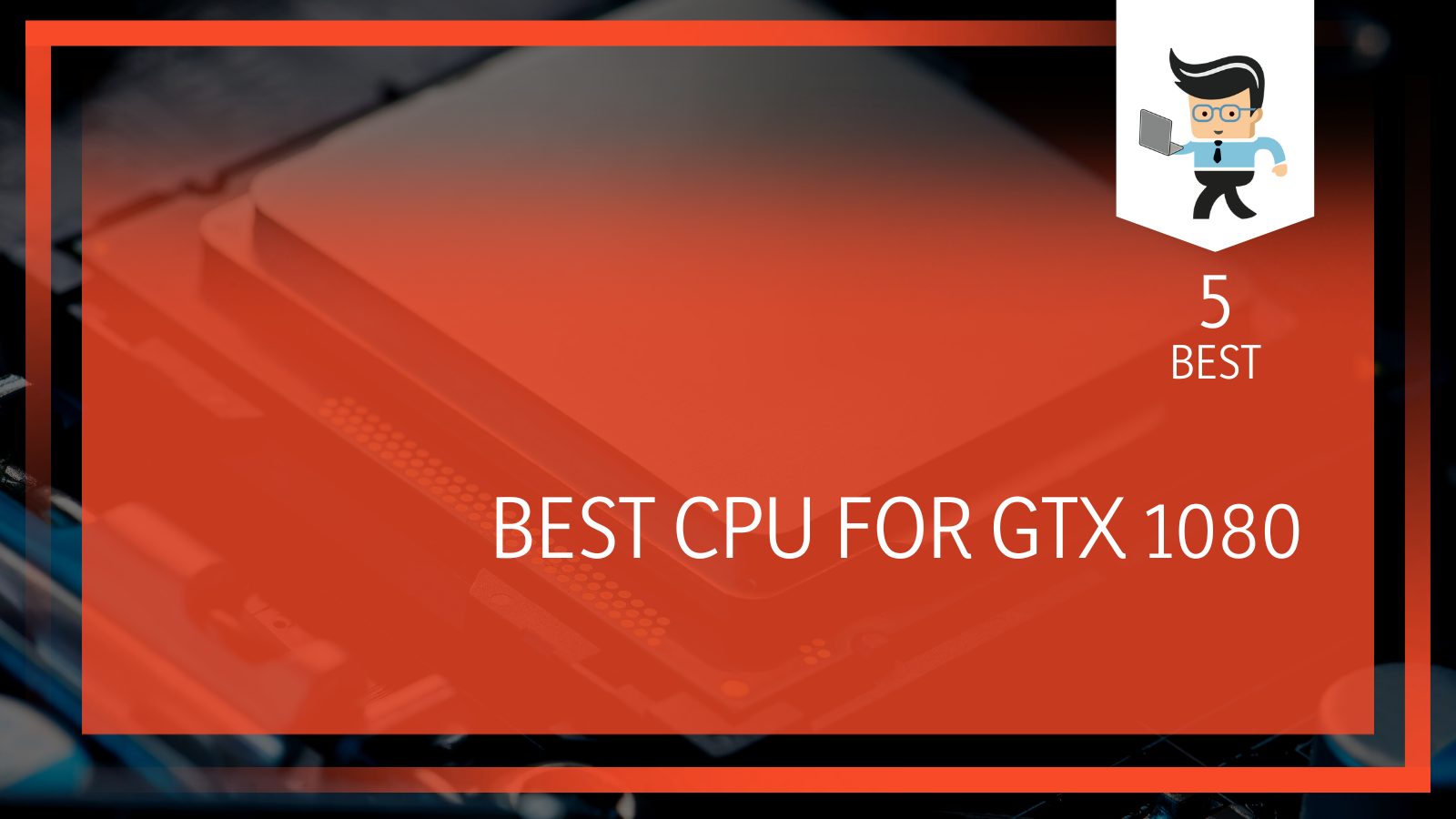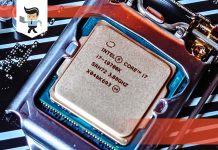Searching for the best CPU for GTX 1080 that can match every part of your rig isn’t an easy journey with many options in the market. Whether you want Intel or AMD variations, our review has the best choices from both brands guaranteed to boost your experience and rig’s performance.

We will look at four of these products and discuss their builds, features, capabilities, and drawbacks to help you make the right decision. If you find yourself in this dilemma, you don’t have to worry as our complete guide has everything you need to know!
Comparison Table
| Product | Details |
|
|
|
|
|
|
|
The 4 Best Processor for GTX 1080 Reviews
Whether you’re a tech freak or someone longing to build a reasonable PC with the GTX 1080, you’re in the right place. We’ll share the top features of each product and how their capabilities can meet your expectations. Of course, what they lack in performance will also form part of the individual reviews, so keep reading to learn every essential detail on the kind of CPU to get.
1. Intel Core i5-8400 Desktop Processor
Pros
- Excellent six-core value and smart cache
- Dual-channel capabilities
- Quality speed levels for fast transitions
Cons
- A blue-screen error may occur in some cases
It’s no secret that Intel presents the finest technologies ever, and a good proof of that is the Intel Core i5-8400 CPU to pair with GTX 1080. It’s worth getting, and if you’re an entry-level user who appreciates your processor’s stability and compatibility, you can pick it. The features and qualities you come across are worth the hype.
The level of components you get on this processor will be compatible with many different devices. However, such devices, especially motherboards, must be based on the Intel 300 Series Chipsets.
Speed levels can reach up to a 4.00 GHz Max Turbo Frequency from this fantastic processor. Also, you are getting six cores that can get to twelve with hyperthreading experience. It also carries the Intel UHD Graphics 630 and a memory speed tagged at 2800 MHz. That is stunning for its level, and the processor is easy to install and handle. The stability on offer is a great advantage coupled with the 9 MB L3 cache.
Many processors are judged on their ability to run intensive games smoothly or overclock. That’s why we think this is the Coffee Lake chip for gamers. While overclocking on the Intel Core i5-8400 won’t make much difference to your performances, the features will combine well to deal with high temperatures from games.
It’s easy to handle and has enough power to help you complete your tasks. The i5-8400 is a good fit for your GTX 1080.
Overview
With a professor featuring amazing opportunities for gaming, easy handling, and top components, you’ll have a straightforward experience on any task. For these reasons, the i5-8400 is suited to entry-level gamers and beginners, thanks to its budget-friendly appeal and cool features.
2. AMD Ryzen 7 2700X Processor with Wraith Prism LED Cooler
Pros
- Exceptional performance
- Innovative inclusion of CPU cooler and software
- Higher clocks
- Better memory compatibility
Cons
- Will pull high energy loads
You know you’re in for a max performance when your preferred CPU comes with a Wraith Prism LED cooler. AMD introduced the Ryzen to counter some models released by its Intel Rivals. You get a professor with high core counts and better-multithreaded performance. In many climes and for a vast number of users, the 2700X is a budget superstar, and we tend to agree!
While the AMD Ryzen 7 2700X might feature the same eight-core and sixteen-thread configuration as its predecessor, it is significantly faster with a 3.7GHz base clock and 4.3GHz boost. A lot of that speed comes from the Ryzen 2nd Generation’s new 12nm Zen+ architecture. According to AMD, its chips provide 16 percent better performance and 11 percent lower power draw than the 2700X’s pre-generation processor running at the same clock speed.
As one of the recommended CPU for GTX 1080, it is compatible with a host of systems, including Windows 10 64 Bit Edition, RHEL x86 64 Bit, and Ubuntu x86 64 Bit. The 4.3 GHz CPU speed is more than any other processor reviewed in this list.
With the higher frequencies the Ryzen 2nd generation can achieve, the 7 2700X overtakes the Intel Core i7-8700K in all single-core benchmarks. Furthermore, the processor continues to hold onto AMD’s crown for the best multi-core performance. The figures you see improve overall performance since the Ryzen 7 2700X can encode files with the highest frame rate. That’s more than the other processors in this review.
The inclusion of the Wraith Prism cooler and AMD’s StoreMI technology makes it easier to go over intensive tasks. Imagine playing games for extended hours with a Wraith cooler to provide stable temperatures.
Overview
This processor’s improved and impressive features cannot go unnoticed and make the device carry more value. It will do well in the rigs of steady gamers and high-intensity users.
3. AMD Ryzen 5 2600X Processor with Wraith Spire Cooler
Pros
- Many cores and threads for multithreading
- Impressive gaming performance
- Includes Wraith Spire Cooler
- Unlocked multiplier for overclockers
Cons
- No integrated GPU
The Ryzen 5 2600X fulfills many GTX 1080 CPU requirements, including having the right chipset, speed, and memory support. It’s a bit different in features and capabilities from the initial flagship mainstream Ryzen 7 2700X processor. However, it still does well with six cores and twelve threads and will consume less power in any situation than the former. It’s an excellent value midrange device for gamers, streamers, and content creators who want to run at stock speeds.
As you’d expect from the AMD brand, this processor has many quality features and specifications. Some of them include a 4.2 GHz CPU speed, a base clock of 3.6GHz, and the much-needed Wraith Spire Cooler. Along with other components, these features will help you reach higher performance levels.
The Precision Boost ensures that all threads are pushing the highest frequencies they can at all times. Also, you get the Extended Frequency Range 2 (XFR2) working across all cores. In addition, the processor utilizes the Intel Coffee Lake’s 14nm process.
With the Ryzen’s 2nd Generation higher clock speeds, the Ryzen 5 2600X’s performance numbers are boosted. We checked the single-core test numbers, and this processor didn’t disappoint on many parameters.
When it comes to gaming performance, the numbers are impressive enough, but that shouldn’t stop you from using the CPU for other tasks. As such, you can encode videos or stream them. However, the Ryzen 5 2600X is a power-hungry running chip. Perhaps that’s why AMD included the Wraith Spire cooler. You can run the tasks mentioned above and still have a moderate temperature running the Ryzen 5 2600X.
Overview
If you’re looking for a chip to perform heavy multitasking and intensive tasks like gaming and video editing, the Ryzen 5 2600X won’t disappoint. We recommend it for users who want a mid-range gaming processor for their rig.
4. Intel Core i7-8700K Desktop Processor
Pros
- Excellent hyper-threading ability
- Low-impact overclocking
- Strong gaming performance
- Improved integrated graphics
Cons
- Requires new motherboard
The Intel Core i7-8700K is one of the best processors in the Coffee Lake lineup, sporting six cores, twelve threads, and higher core clocks than any AMD Ryzen chips. You’ll find using this CPU easy and wholesome with top gaming performance and hyperthreading numbers. It overclocks like a champ and puts Ryzen chips in the shadow.
While the professor has two fewer cores than its Red-colored rivals, the i7-8700K pulls ahead with higher base and boost clocks of 3.7 and 4.7GHz, respectively. As a hexa-core mainstream processor, this is a big step forward for Intel and a step above its rivals. You might need a new motherboard with this processor, as older Z270 platforms don’t support the 9th-generation’s higher power delivery demands.
You have to give it up to Intel for squeezing eighteen cores into the Intel Core i7-8700K. Even with that, we already mentioned that you’d need a new motherboard. The motherboard you get must be based on Intel’s 300 Series Chipsets. Other than that, you get the Intel UHD Graphics 630 and 3.70 GHz up to 4.70 GHz Max Turbo Frequency alongside a 12 MB cache.
Further, the Coffee Lake design uses a 14nm++ profess, which according to Intel, offers 26 percent more performance and 52 percent less leakage power than first-generation 14nm manufacturing. Those advances are responsible for the higher Turbo Boost bins and limit consumption enough to enable extra cores. Still, on the Turbo Boost, it allows the CPU to operate beyond its rated TDP. To do that, current, power, and temperature must fall below specified limits.
The Core i7-8700K also supports speedier DDR4-2666 transfer rates, which is more than we can say for its predecessor. Also, the PCIe connectivity remains the same. You’ll get sixteen lanes of third-generation of PCIe from the CPU’s controller.
The Intel Core i7-8700K comes with the brand’s multi-core performance up to and well above the high benchmark Ryzen had set when it was released. It will have excellent scores in several parameters than the previous generation, like the Intel Core i7-8700K and its multi-core numbers. Moreover, the processing power helps the 8700K convert video as fast as some of the industry’s most overpowered CPUs.
For gaming, this i7-8700K goes beyond what’s expected of the minimum CPU for GTX 1080. Our tech team noted a sharp improvement over the last generation, thanks to the new hexa-core CPU, which increased frame rates across the board. Other enhancements include Full HD and Ultra quality settings.
Overclocking and heat are other things to consider for gaming and other intensive applications. With more core counts, it’s only normal to expect a rise in Power consumption. As a result, the i7-8700K consumes twice the power as its Kirby Lake predecessors. However, when idle, the six-core chip consumes power at an average of five watts, less than what’s obtainable from the AMD Ryzen 1700X. That means more energy efficiency for you.
When it takes extra power to run some applications, expect it to go beyond the rated maximum 4.7GHz frequency. You’ll quickly achieve a 5.0GHz frequency across all the cores by giving the processor an extra 0.02 volts of juice. The max temperature will increase from that, but not at a level detrimental to your operations.
Overview
One of the hard things some users struggle to accept with this processor is getting a new motherboard to use the Coffee Lake-S. However, the processor is designed for gamers, and that’s a sacrifice worth making, especially for the highest benchmark numbers.
Buying Guide
When you have a graphics card that meets all your requirements, it’s only normal that other components should follow suit. To that end, a worthy processor either from the Intel or AMD brand is a necessity. That’s because the GTX 1080 cards are designed to target 1440p or 4K resolution. Our experts have come to the conclusion that purchasing an Intel Core i7-8700K desktop processor is the best way to go.
In your search for a good CPU for GTX 1080, consider these essential features and factors.
– Benefits of the Intel Core i7-8700K Desktop Processor
The greatest benefits of getting the Intel i7-8700K is that it has excellent hyper-threading ability, low-impact overclocking, a strong gaming performance, and highly improved integrated graphics. It is one of the best processors in the Coffee Lake lineup, sporting six cores, twelve threads, and higher core clocks than any AMD Ryzen chips.
– Cores
Cores are essential requirements for a CPU. They’re referred to as the CPU’s professor. With more cores, you get more and better performances across different functions. Modern-day professors have between two to eighteen cores to handle various tasks. This will boost and maintain the efficiency of your computer.
Props to Intel for being able to place eighteen cores into the Intel Core i7-8700K.
– Memory Speed
You need adequate speed and RAM if you want to play high graphics games or run other intensive applications on your PC. Ensure that the processor you choose supports up to 16GB of RAM to be compatible with the GTX 1080.
– Cache
The importance of a cache is often understated. It’s a memory attached to the CPU, and data is stored in this memory while the processor is running. When you have higher amounts of cache, the speed and performance of the processor get better. You must look for a higher cache if your main objective is gaming.
– Overclocking
In more ways than one, you need a CPU that overclocks. It has become if you want to run your GTX 1080. Note that overclocking the CPU on a computer is much more complicated than a graphics card because the CPU has to interact with other system components. Without any restrictions on overclocking from brands, it’s an excellent feature to look out for, especially if you play games.
The Intel Core i7-8700K desktop processor boasts of low-impact overclocking abilities.
– Chipset
A chipset is another component to consider. When you have a high-end chipset, it lets you enjoy the full support of a wide range of hardware. For your GTX 1080, you must get the best CPU based on high-end chipsets. The products reviewed above all carry high-end chipsets, especially the Intel i7-8700K.
– Socket Type
The professor connects to the motherboard via a socket using level arcs, clips, or screws. The LGA 1151 is a suitable socket type. Sockets vary from company to company, so you must choose the ideal LGA socket type for GTX 1080.
– Quality
When you start ticking off the vital parts of your PC, there’s no leaving out the CPU, especially if it’s for your GTX 1080 build. At a time when the components of modern processors are processed in under a minute and their development in the technology sector shows no signs of slowing down, knowing what a processor is and how to make the most of it is essential knowledge for every builder, gamer, and computer programmer who wants to create high-quality software.
Using an ordinary option will leave your PC with below-par quality and frequent lags. For these reasons, we have produced this in-depth article with four of the best processors in the market.
Final Words
A CPU must contain at least four threads to function properly with a GTX 1080 graphics card. We have painstakingly gone through these products and concluded that the Intel Core i7-8700K presents the best option for your GTX 1080 graphics card. It has top-level aspects that make it a gaming spectacle, including top Turbo Boosts and speeds, cache space, and overclocking ability.
When looking for the best companion for your GTX 1080, consider the hyperthreading performance and power efficiency of the i7-8700K from Intel.








